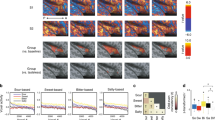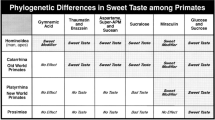Summary
The neural coding of taste quality in vertebrates currently is addressed by the labeledline and the across-fiber pattern theory. Experimental tests that have tried to distinguish between these theories by manipulating taste quality have been problematic in that both are fairly successful. However, the two theories maintain that different numbers of neurons participate in coding the presence of a substance. In the labeled-line theory, only those neurons labeled by that substance are supposed to be involved, whereas in the across-fiber pattern theory, all neurons responding to the substance are taken into account. We therefore expected that the theories might predict different intensity discriminating abilities among the four classical taste stimuli, which could provide a less equivocal test between the theories.
A previous paper (Maes 1984) described a model for the neural basis of intensity discrimination, based on signal-detection theory. In the present paper, experimental data obtained from single neurons in the nucleus of the solitary tract of rat are analyzed in terms of this model. Whole-mouth stimulation with the four classical taste substances was used. For both theories, predictions of the intensity discriminating acuity for the four substances were derived, using different response analysis intervals, and including two plausible non-linearities in neural processing.
The ‘acuity profile’ across the four stimuli (consisting of the reciprocals of the four differential thresholds) turned out to be sensitive to the choice of coding theory and non-linearity. The interval chosen for response analysis had a strong effect. The predicted profiles should be checked against behavioral data on intensity discrimination in rat, but since such data are not yet available, a comparison was made with human psychophysical data, for illustrative purposes. It appeared that a unique combination of variables (tonic part of the response, across-fiber pattern coding with a ‘contrast enhancement’ type of non-linearity) could be selected to match the psychophysical profile.
In the Discussion, special attention is paid to the fundamental differences between the two coding theories, to the relevance of whole-mouth stimulation, and to the informational significance of various parts of the phasic/tonic response.
Similar content being viewed by others
Abbreviations
- AFP :
-
across-fiber pattern
- CT :
-
chorda tympani
- DA :
-
discrimination acuity
- DT :
-
differential threshold
- H :
-
sour
- LL :
-
labeled line
- N :
-
salty
- NTS :
-
nucleus tractus solitarius
- PTA :
-
pontine taste area
- Q :
-
bitter
- S :
-
sweet
References
Bealer SL (1978) Intensity coding in the transient portion of the rat chorda tympani response. J Comp Physiol Psychol 92:185–195
Beidler LM (1961) Taste receptor stimulation. Progr Biophys Biophys Chem 12:107–151
Campbell BA (1958) Absolute and relative sucrose preference thresholds for hungry and satiated rats. J Comp Physiol Psychol 51:795–800
De Jonge H (1964) Inleiding tot de medische statistiek, vol II (2nd ed.). Wolters-Noordhoff, Groningen
Dickman JD, Sweazey RD, Smith DV (1982) Converging taste receptor inputs to the hamster solitary nucleus. Abstr 4 th Annu Meet Ass Chemorec Sci, Sarasota Fl, April 14–18, p7
Di Lorenzo PM, Schwartzbaum JS (1982a) Coding of gustatory information in the pontine parabrachial nuclei of the rabbit: Magnitude of neural response. Brain Res 251:229–244
Di Lorenzo PM, Schwartzbaum JS (1982b) Coding of gustatory information in the pontine parabrachial nuclei of the rabbit: Temporal patterns of neural response. Brain Res 251:245–258
Doetsch GS, Erickson RP (1970) Synaptic processing of tastequality information in the nucleus tractus solitarius of the rat. J Neurophysiol 33:490–507
Doetsch GS, Ganchrow JJ, Nelson LM, Erickson RP (1969) Information processing in the taste system of the rat. In: Pfaffmann C (ed) Olfaction and taste, vol 3. Rockefeller University Press, New York, pp 492–511
Erickson RP (1963) Sensory neural patterns and gustation. In: Zotterman Y (ed) Olfaction and taste, vol 1. Pergamon Press, Oxford, pp 205–213
Erickson RP (1966) Nontraumatic headholders for mammals. Physiol Behav 1:97–98
Erickson RP (1967) Neural coding of taste quality. In: Kare MR, Maller O (eds) The chemical senses and nutrition. Johns Hopkins Press, Baltimore Md, pp 313–327
Erickson RP (1968) Stimulus coding in topographic and non-topographic afferent modalities: On the significance of the activity of individual sensory neurons. Psychol Rev 75:447–465
Erickson RP (1977) The role of ‘primaries’ in taste research. In: Le Magnen J, MacLeod P (eds) Olfaction and taste, vol. 6. Information Retrieval Ltd, London, pp 369–376
Erickson RP (1982) The across-fiber pattern theory: An organizing principle for molar neural function. Contrib Sens Physiol 6:79–110
Erickson RP (1984) Taste: A matter of definition. Rockefeller University Press, New York, (in press)
Erickson RP, Covey E (1980) On the singularity of taste sensations: What is a taste primary? Physiol Behav 25:527–533
Erickson RP, Schiffman SS (1975) The chemical senses: A systematic approach. In: Gazzaniga MS, Blakemore C (eds) Handbook of Psychobiology. Academic Press, New York, pp 393–426
Erickson RP, Doetsch GS, Marshall DA (1965) The gustatory neural response function. J Gen Physiol 49:247–263
Frank M (1973) An analysis of hamster afferent taste nerve response functions. J Gen Physiol 61:588–618
Frank M (1975) Response patterns of rat glossopharyngeal taste neurons. In: Denton DA, Coghlan JP (eds) Olfaction and taste, vol 5. Academic Press, New York, pp 59–64
Ganchrow JR, Erickson RP (1970) Neural correlates of gustatory intensity and quality. J Neurophysiol 33:768–783
Gill JM, Conley M, Maes FW, Erickson RP (1982) Response properties of hamster pontine taste neurons to a broad range of sapid stimuli. Abstr 4th Annu Meet Assoc Chemorec Sci, Sarasota Fl, April 14–18, p 10
Halpern BP (1975) Temporal patterns of liquid intake and gustatory neural responses. In: Denton DA, Coghlan JP (eds) Olfaction and taste, vol 5. Academic Press, New York, pp 47–52
Halpern BP, Nelson LM (1965) Bulbar gustatory responses to anterior and posterior tongue stimulation in the rat. Am J Physiol 209:105–110
Halpern BP, Tapper DN (1971) Taste stimuli: Quality coding time. Science 171:1256–1258
Hamilton RB, Norgren R (1981) The distribution of gustatory nerves within the nucleus of the solitary tract in rat. Abstr 11th Annu Meet Soc Neurosci Los Angeles, Oct 18–23, p 730
Henning H (1916) Die Qualitätenreihe des Geschmacks. Z Psychol 74:203–219
Kelling ST, Halpern BP (1983) Taste flashes: Reaction times, intensity, and quality. Science 219:412–414
Lester B, Halpern BP (1979) Effect of stimulus presentation duration on gustatory reaction time. Physiol Behav 22:319–324
Maes FW (1984) A neural coding model for sensory intensity discrimination, to be applied to gustation. J Comp Physiol
Maes FW, Erickson RP (1982 a) Assessment of concentration discriminating potential in rat NTS and its relevance to the labeled-line/across-fiber pattern issue. Abstr 4th Annu Meet Assoc Chemorec Sci, Sarasota Fl, April 14–18, p 18
Maes FW, Erickson RP (1982b) Intensity coding in rat taste organ. Abstr 5th Congr Eur Chemorec Res Org, Regensburg FRG. Sept. 5–9, p 47
Marowitz LA, Halpern BP (1977) Gustatory neural response of the chorda tympani to lick-duration stimuli. Chem Senses Flavor 2:457–485
McBurney DH (1976) Temporal properties of the human taste system. Sens Proc 1:150–162
McBurney DH, Gent JF (1979) On the nature of taste qualities. Psychol Bull 86:151–167
McBurney DH, Shick TR (1971) Taste and water taste of twenty-six compounds for man. Percept Psychophys 10:249–252
Meiselman HL, Bose HE (1977) Effects of flow rate on taste intensity ratings. Chem Senses Flavor 2:515–522
Miller IJ (1977) Gustatory receptors of the palate. In: Katsuki Y, Sato M, Takagi SF, Oomura Y (eds) Food intake and chemical senses. University of Tokyo Press, Tokyo, pp 173–185
Miller IJ, Spangler KM (1982) Taste bud distribution and innervation on the palate of the rat. Chem Senses 7:99–108
Mood AM, Graybill FA, Boes DC (1974) Introduction to the theory of statistics. McGraw-Hill Kogakusha, Tokyo
Nagai T, Ueda K (1981) Stochastic properties of gustatory impulse discharges in rat chorda tympani fibers. J Neurophysiol 45:574–592
Norgren R, Pfaffmann C (1975) The pontine taste area in the rat. Brain Res 91:99–117
Nowlis GH, Frank M (1977) Qualities in hamster taste: Behavioral and neural evidence. In: Le Magnen J, MacLeod P (eds) Olfaction and taste, vol 6. Information Retrieval Ltd, London, pp 241–248
Nowlis GH, Frank ME, Pfaffmann C (1980) Specificity of acquired aversions to taste qualities in hamsters and rats. J Comp Physiol Psychol 94:932–942
Perrotto RS, Scott TR (1976) Gustatory neural coding in the pons. Brain Res 110:283–300
Pfaffmann C (1941) Gustatory afferent impulses. J Cell Comp Physiol 17:243–258
Pfaffmann C (1974) The sensory coding of taste quality. Chem Senses Flavor 1:5–8
Pfaffmann C, Frank M, Bartoshuk LM, Snell TC (1976) Coding gustatory information in the squirrel monkey chorda tympani. Progr Psychobiol Physiol Psychol 6:1–27
Pfaffmann C, Frank M, Norgren R (1979) Neural mechanisms and behavioral aspects of taste. Annu Rev Psychol 30:283–325
Schiffman SS, Erickson RP (1971) A psychophysical model for gustatory quality. Physiol Behav 7:617–633
Schiffman SS, Erickson RP (1980) The issue of primary tastes versus a taste continuum. Neurosci Biobehav Rev 4:109–117
Schutz HG, Pilgrim FJ (1957) Differential sensitivity in gustation. J Exp Psychol 54:41–48
Scott TR (1974) Behavioral support for a neural taste theory. Physiol Behav 12:413–417
Scott TR, Erickson RP (1971) Synaptic processing of taste-quality information in thalamus of the rat. J Neurophysiol 34:868–884
Scott TR, Perrotto RS (1980) Intensity coding in pontine taste area: Gustatory information is processed similarly throughout rat's brainstem. J Neurophysiol 44:739–750
Smith DV, Bealer SL (1975) Sensitivity of the rat gustatory system to the rate of stimulus onset. Physiol Behav 15:303–314
Smith DV, Travers JB, Van Buskirk RL (1979) Brainstem correlates of gustatory similarity in the hamster. Brain Res Bull 4:359–372
Smith DV, Van Buskirk RL, Travers JB, Bieber SL (1983a) Gustatory neuron types in hamster brainstem. J Neurophysiol 50:522–540
Smith DV, Van Buskirk RL, Travers JB, Bieber SL (1983b) Coding of taste stimuli by hamster brain stem neurons. J Neurophysiol 50:541–558
Van Buskirk RL, Smith DV (1981) Taste sensitivity of hamster parabrachial pontine neurons. J Neurophysiol 45:144–171
Woolston DC, Erickson RP (1979) Concept of neuron types in gustation in the rat. J Neurophysiol 42:1390–1409
Yamamoto T, Kawamura Y (1981) Gustatory reaction time in human adults. Physiol Behav 26:715–719
Yamamoto T, Kato T, Matsuo R, Araie N, Azuma S, Kawamura Y (1982) Gustatory reaction time under variable stimulus parameters in human adults. Physiol Behav 29:79–84
Author information
Authors and Affiliations
Rights and permissions
About this article
Cite this article
Maes, F.W., Erickson, R.P. Gustatory intensity discrimination in rat NTS: a tool for the evaluation of neural coding theories. J. Comp. Physiol. 155, 271–282 (1984). https://doi.org/10.1007/BF00612644
Accepted:
Issue Date:
DOI: https://doi.org/10.1007/BF00612644




